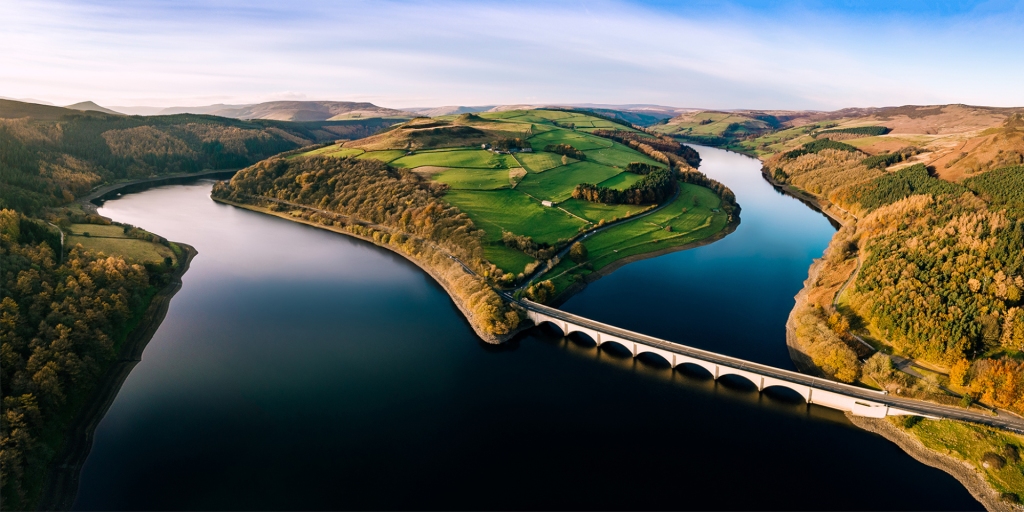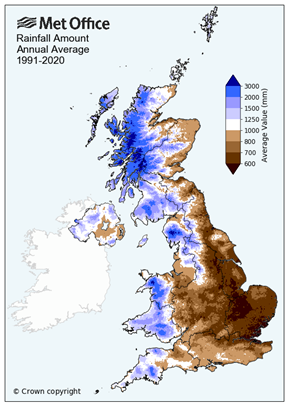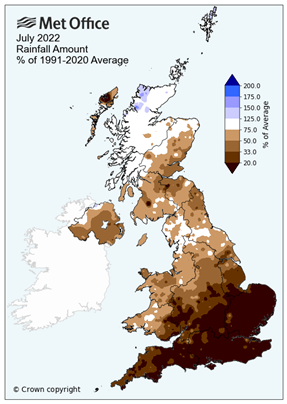This month we’re exploring the climate theme of ‘water security’. Water Security, as defined by the World Meteorological Organization (WMO), refers to ‘a population’s capacity to safeguard sustainable access to adequate quantities of acceptable quality water.’
At the Met Office, we work alongside organisations in the water sector to help support resilience and planning through the provision of weather and climate data and expertise. In this blog post, we’ll explore the link between climate change and water security and learn about some of the work that we have undertaken in this space.

Climate change and increasing heat drought events
In November 2022, the WMO published its first State of Global Water Resources report which assessed the effects of climate, environmental and societal change on water resources. At the time, WMO Secretary-General Professor Petteri Taalas said, “The impacts of climate change are often felt through water – more intense and frequent droughts, more extreme flooding, more erratic seasonal rainfall and accelerated melting of glaciers – with cascading effects on economies, ecosystems and all aspects of our daily lives. And yet, there is insufficient understanding of changes in the distribution, quantity, and quality of freshwater resources.”
As the climate continues to change as a result of greenhouse gas emissions, we are seeing increasingly hot, dry conditions in the UK and globally. 2022 has recently been confirmed as the hottest year on record for the UK with an annual average temperature of over 10°C, and this trend is projected to continue in the future. July 2022 saw the driest month since 1935 for England as a whole, and the driest on record for East Anglia, southeast and southern England, with the UK seeing just 56% of its average rainfall for the month. As a result, drought was declared by the Environment Agency in many parts of the UK in August 2022.


Impacts of drought on water security
Rising temperatures and increasing instances of drought events could have significant implications for water security. In 2020, the Environment Agency published a National Framework for Water Resources which showed that under the current trajectory, the amount of water available in England could be reduced by 10-15%, with some rivers seeing up to an 80% decrease in water during the summer months.
An Environment Agency spokesperson said: “Our climate is changing; the summer of 2022 demonstrates this. Action must be taken now, to ensure we are ready for managing droughts in the short term. As our National Framework for Water Resources shows, we need to develop new sustainable long-term supplies of water and for people and business to use water wisely to protect our precious water resources. In the short term the Government, Environment Agency, water companies, farmers, environmental and angling groups continue to work together through the National Drought Group to balance water needs and manage impacts if we experience prolonged dry weather again.”
How can we respond to threats to water security?
Climate change projections indicate that rainfall patterns in the UK will shift, which could present additional water security challenges to regional water providers. It is vital that water companies have access to the latest research, advice and accurate meteorological projections, so that they can effectively manage water supplies in their area.
The Met Office has been working with water company Anglian Water to support water resource management for the East Anglia region, one of the areas which is projected to be most affected by water scarcity.
By using novel approaches and new datasets, the Met Office worked alongside Anglian Water to strengthen their understanding of drought risk – both for today and for the future, in a warmer world. This improved understanding enables Anglian Water to enhance their resilience to future drought events.
Dr Joe Osborne is an Industry Consultancy Manager at the Met Office. He said: “As part of this work, the Met Office Industry Consultancy team has developed a statistical model to enhance Anglian Water’s understanding of extreme events. The model is used to generate 1,000 alternative realisations of a 105-year historical period (1914-2018), with daily outputs on a 5km grid over the region. The output validates rainfall and drought behaviour well, providing confidence in the suitability our datasets for future scenario planning.”
At the Met Office, we provide a range of weather and climate services to help support resilience, efficiency and forward planning for the water sector. This includes investigations into historical instances and future projections of drought, river flow analysis and consultancy around climate change projections. With meteorological expertise and knowledge of the latest advances in water resource planning, our consultants can help the water sector to mitigate the impact of weather and climate, adapt to changes and capitalise on the potential benefits of future weather events (for example, average increases in winter rainfall could improve resilience of supply with the appropriate resource management solutions).
Geoff Darch, Head of Supply Demand Strategy for Anglian Water concluded: “Understanding the investment decisions that are required to protect our customers against future weather and climate extremes is paramount. We need to make decisions based on robust and defendable science. Undertaking this challenging work with the Met Office means that data-driven investments are made where appropriate, ensuring that we better protect our customers and the environment we serve in the face of an ever-changing climate.”

You must be logged in to post a comment.